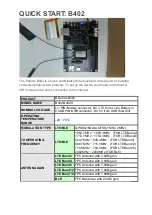
36
ATZB-EVB-XXX-XXX User Manual
AVR-09-2011
Due to flexibility of AT-commands, you can create other network scenarios
addressing the specific needs of your application. The examples are recommended
as a starting point in evaluation of SerialNet.
A variety of terminal programs provide capability to enter AT-command scripts and to
analyze the responses from a board. In order to run the SerialNet application, follow
step-by-step instructions from the
Examples
section of the document [3].
NOTE:
The
+IFC
and
+IPR
commands both change the rate and flow control
parameters of Serial/USB port. If any of these commands is used, the
COM port settings on the terminal program running on the PC should
be changed accordingly.
7 Serial Bootloader
Serial Bootloader is software intended to burn firmware images in SREC format into
WSN nodes without using JTAG (see 10.8). It also provides the capability to set up
the network parameters for each node without altering its firmware manually.
Serial Bootloader consists of two parts: a PC application for Windows platforms
(supplied in console and GUI versions) and bootstrap code residing in the MCU. In
ZigBit Development Kit, each ATZB-EVB (MeshBean) board is delivered with fuse
bits set up and the bootstrap preloaded to ZigBit MCU. Bootstrap itself can be
recovered using JTAG when necessary. It is supplied in form of
bootloader.hex
image file (see 10.7).
Exhaustive information on using Serial Bootloader is contained in [7].
8 Programming with BitCloud API
8.1 API Overview
BitCloud internal architecture follows 802.15.4, ZigBee-defined separation of the
networking stack into logical layers. Besides the core stack containing protocol
implementation, BitCloud contains additional layers implementing shared services
(e.g. task manager, security, and power manager) and hardware abstractions (e.g.
hardware abstraction layer (HAL) and board support package (BSP)). The APIs
contributed by these layers are outside the scope of core stack functionality.
However, these essential additions to the set of APIs significantly help reduce
application complexity and simplify integration. BitCloud Stack Documentation [4]
provides detailed information on all public APIs and their use.
The topmost of the core stack layers, APS, provides the highest level of networking-
related APIs visible to the application. ZDO provides a set of fully compliant ZigBee
Device Object APIs which enable main network management functionality (start,
reset, formation, join). ZDO also defines ZigBee Device Profile types, device and
service discovery commands implemented by the stack.
There are three service "planes" including: task manager, security, and power
manager. These services are available to the user application, and may also be
utilized by lower stack layers. Task manager is the stack scheduler which mediates
the use of the MCU among internal stack components and user application. The task
manager utilizes a proprietary priority queue-based algorithm specifically tuned for
multi-layer stack environment and demands of time-critical network protocols. Power















































